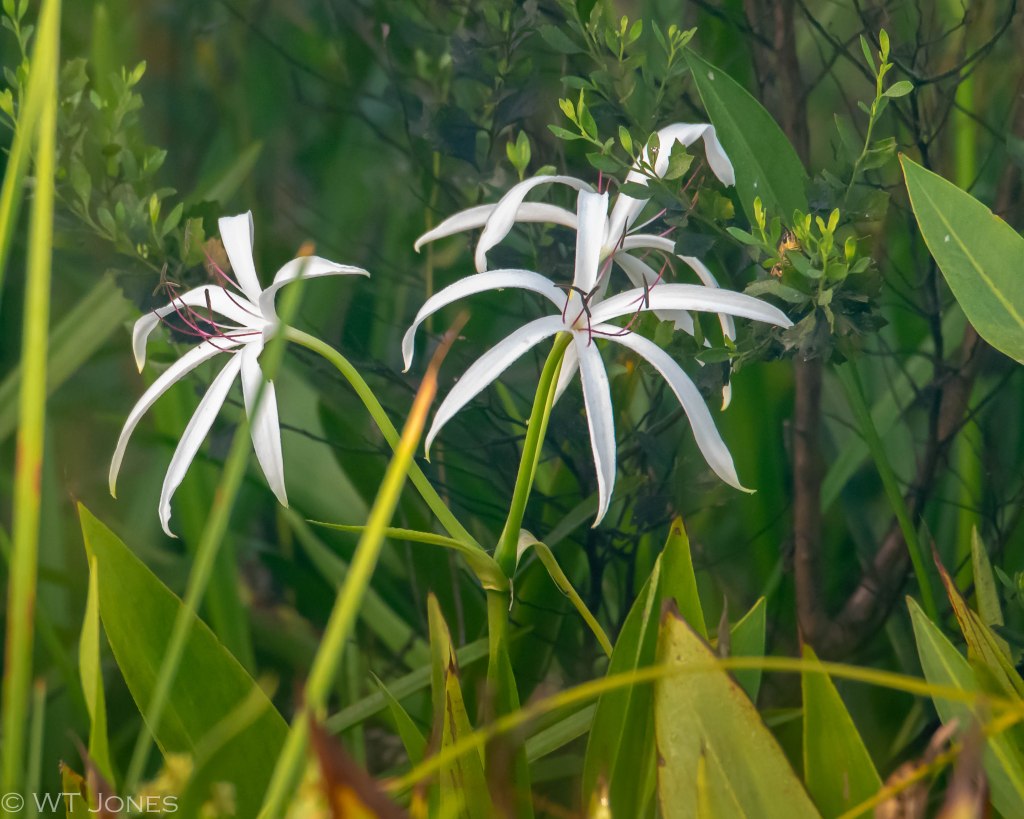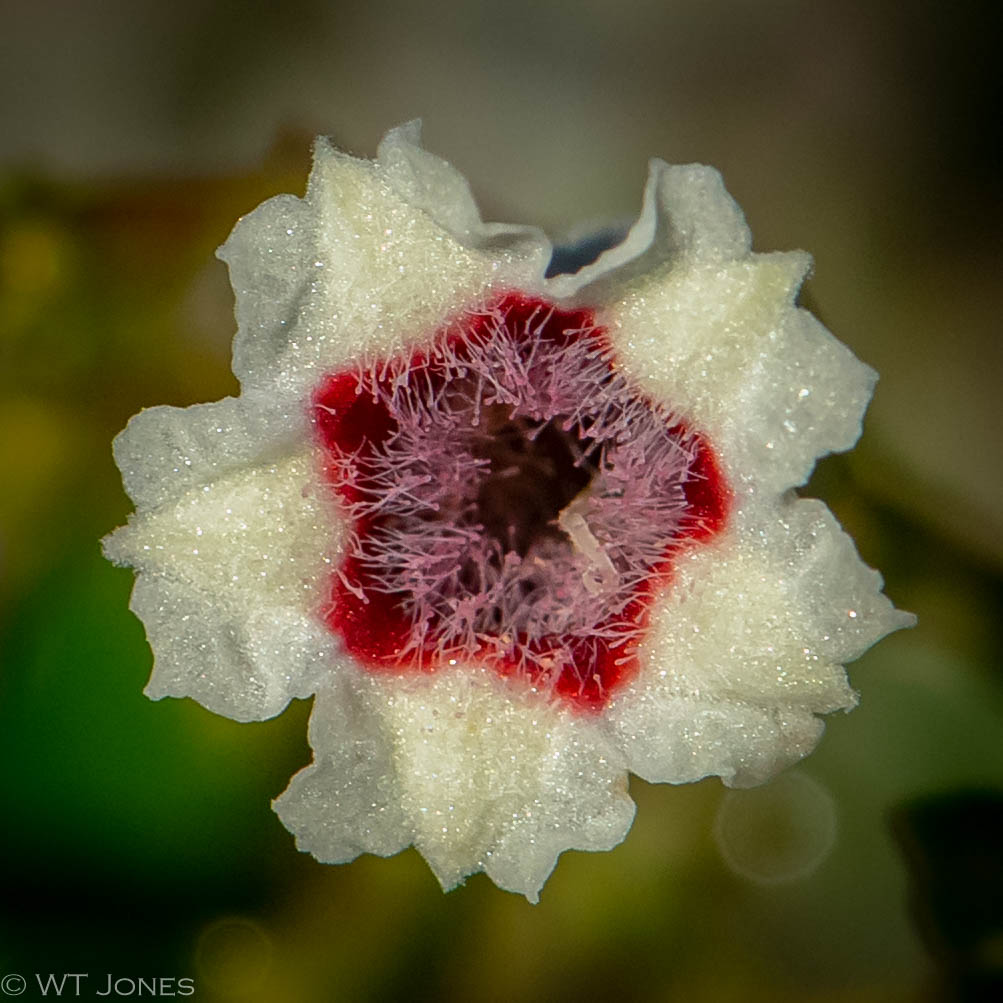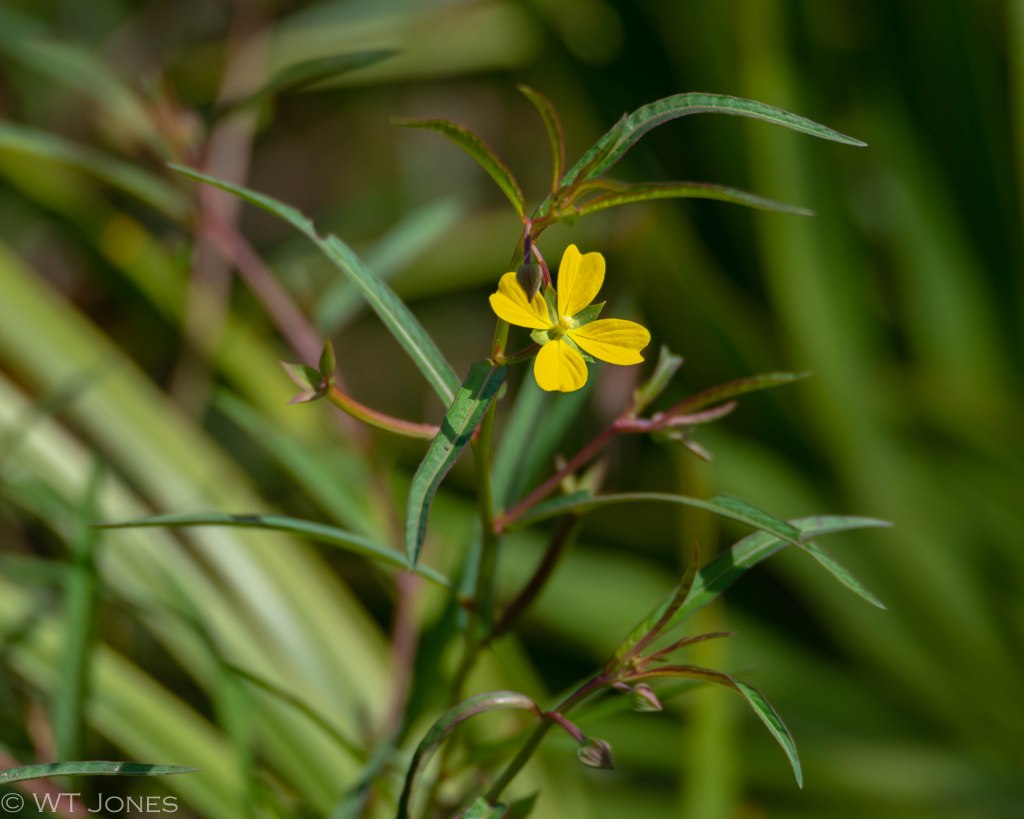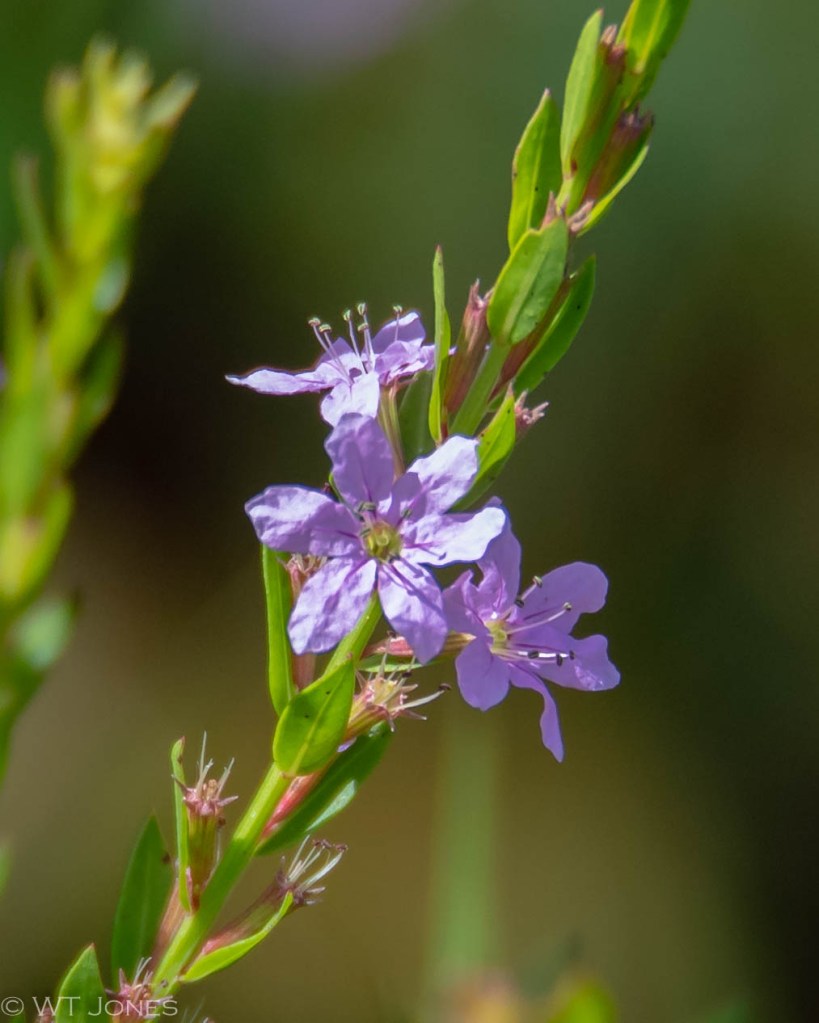Go For The Birds, Enjoy The Rest
Header Image: Immature White Ibis
Why does food taste better in the forest? I mean, a boiled egg is a boiled egg. Eaten at the dining table in comfortably conditioned air and protected from natural elements, it is satisfying. Taking a bite of that same hen fruit under a canopy of pine boughs, surrounded by yellow blooms, purple berries, hammering woodpeckers, yammering jays, brown-eyed deer and with a background of a cacophonous cicada chorus – well, the lowly egg has become a veritable feast for the memory.
Our early morning foray into the forest at the edge of central Florida’s Green Swamp began in fog. Stillness. Silence. Wonderful.
Blue sky was visible above the grayness and within an hour after sunrise, the mist had dissipated. Nature awoke. The sounds of the day greeted us from all sides. Against a green brushy backdrop, Gini spotted the delicate form of a String Lily. Stepping closer to the bright white bloom, a large bright yellow Lubber Grasshopper inched lower on a plant stalk, just in case we were potential predators.
With “autumn”* just around the bend, we were hoping to spot early bird migrants. Excitement rose when a Belted Kingfisher flushed from a small pool, perched in a pine tree and chattered her disapproval of our presence. Other likely migratory birds we saw during the morning included a large number of Blue-gray Gnatcatchers, a few Red-eyed Vireos and a couple of American Redstarts. This, in addition to almost 40 additional (resident) species made the morning a very respectable birding effort.
(*Autumn in the middle of Florida is a term associated with a calendar. The only noticeable difference for us is the appearance of migrating birds. Florida’s autumn is an extension of Florida’s “green” season and a prelude to our “brown” season.)
Over the years we have made a significant scientific observation. As we busied ourselves searching for birds, we discovered a whole bunch of other stuff Nature has to offer! In the same habitat which supports bird life, there is an amazing variety of plants, insects and other animals. Who knew?
Increasingly, we find ourselves so fascinated by a flower or a bug that we almost forget we are bird watchers. Almost.
A small sampling of Nature’s diversity coming right up.
The Belted Kingfisher does breed in parts of Florida, although we are at the southern limit of that range. We visit this area frequently and don’t typically see one during the summer, so this young lady is almost certainly a migrant.

A delicate String Lily (Crinum americanum) brightened up the otherwise green landscape. Also known as Swamp Lily, this aromatic beauty is similar to the Spider Lily (Hymenocallis spp.) but the flower does not have the staminal cup connecting petals like the Spider Lily.

Adding a bit of technicolor to the woods is a large Eastern Lubber Grasshopper (Romalea microptera). One day we’ll talk about their spitting habits.

A very common plant in wet areas is the Bulltongue Arrowhead (Sagittaria lancifolia). Long green leaves supporting tall stalks of white flowers around the lake attract a diverse group of life forms. Sometimes, those life forms remain almost hidden. Like a small crab spider which I didn’t see until processing the image.


“What’s in a name? That which we call a rose – By any other name would smell as sweet.” Perhaps Juliet could have excused the aroma of the Skunkvine (Paederia foetida) and between her and Mr. Shakespeare come up with a more pleasant-sounding moniker. It’s a vine with attractive flowers, but in addition to a foul odor, is also quite noxious in its growing habits, an invasive plant which overcomes native flora.


Gini noticed a group of pretty-in-pink Apple Snail eggs had attracted a Horse Fly (Tabanus atratus). We aren’t sure why the big insect was attracted to the egg cluster, although male Horse Flies are known to feed on nectar.

One of our favorite spiders, the Green Lynx Spider (Peucetia viridans) is fairly common in our area. Still, spotting one among green foliage can be challenging. Or, you can use my tried and true method: l-u-c-k.

A bee! On Beebalm! Who’d a thunk it? Spotted Beebalm (Monarda punctata) and Bumble Bee (Bombus spp.). This plant is also known as Dotted Horsemint. We did not see an actual horse on one today.

There are nearly 30 species of plants belonging to the genus Ludwigia in Florida which can make identification of some quite a challenge. The Narrowleaf Primrosewillow (Ludwigia linearis) simplifies things a bit by having very narrow leaves, rather sparse growth and usually remaining less than a couple of feet tall. The yellow blooms are just as attractive as any in the family!

This small Downy Woodpecker gave me only one chance at a photograph and it is not a good one. The quality of the image does not subtract from the actual beauty of the little bug hunter.

Growing to over three feet tall, Gini thinks the pretty blooms of the Winged Loosestrife (Lythrum lanceolatum) could use an iron. (If you didn’t have to look up “iron” in this context, welcome to pretty-near-to-senior-citizenry.)

Even though I don’t care for the face full of web I often get due to their habit of stringing them across a path, I admire the beauty of the large Golden Silk Spider (Trichonephila clavipes). This lady has invited a friend for breakfast.


We began bird watching many years ago. With each trip we took, it became clear we enjoyed much more than just seeing birds. Nature is so diverse! Hopefully, no matter your specific interest, you will find new and wondrous gifts each time you venture out.
Enjoy your search for a natural place and come back for a visit!
Your observations impress me with how much I miss when out in the wetlands. It must be (or certainly is) my age which causes me to meet the same bug that I encountered only a year ago: “I know your face but I just can’t recall your name… Well howdy do old bloke, you’re looking just about the same!” (Danny Kaye).
LikeLike
Rest assured, it is not just you, Ken!
I remarked to Gini just the other day that it seems each new season I have to research the names of all the critters I just researched last year!
Hey, at least we’re still getting out a bit, so there’s that. 🙂
LikeLike
At last Wally I have caught up with you again. Since no emails of your posts come through to me but I have tried once again to subscribe today again so hopefully this time it might work. Love you banter at the beginning (as usual) and like some of the other bloggers who have commented, birds and all of nature should be enjoyed and photographed. Your close up photography is brilliant Wally and you certainly have not lost your touch. Often only through photography can you see the exquisite and exquisite colours and marking on the smallest of critters. Over the past year i have had 4 major health issues and have been out of action for some time and not even any to comment but just managed a daily post although that was only accomplished when i was well enough to make several and schedule them in however now I am back to “normal” although still have to have a MRI brain scan. I hopoe you and Gini are keeping well and safe. All the best to you both and happy birding.
LikeLike
MARGARET!!
Dia dhuit!
How wonderful to hear from you, although Gini and I are distressed about your health issues. We hope you are truly close to being back to “normal”. Prayers for your continued good health.
Thank you so much for your typical gracious comments. We are so grateful to be able to get out and about and provide small reports on our adventures in Nature.
We have both been very well, safe and are attempting to live each day to the fullest.
Hearing from you has lifted our spirits immensely!
LikeLike
If it’s any help, food tastes better in Greece too. That too must be the weather, not to mention the ouzo.
That Eastern Lubber Grasshopper is very impressive, so beautiful in fact that it’s a real shame it gets eaten by those big greedy birds? So too the Green Lynx Spider, a fabulous beast indeed. I agree, the Skunkvine is deserving of a better name and a better press that its name will inevitable attract.
I posted some pictures from our 2 weeks in Greece. If you and Gini pop over this evening we can view them for real while sharing a glass or two of ouzo. See you soon.
LikeLike
It turns out those big beautiful Lubbers secrete a toxin which makes them unpalatable for most predators. Some diners have been known to die after indulging. One of the smart ones, the shrike, discovered impaling a specimen on a thorn and waiting a couple of days allows the toxin to dissipate and then enjoys ‘hopper jerky with no ill effects.
We’ll be right over to admire your ouzo.
What? Pictures, too? Okay.
LikeLike
As a dedicated birder, I endorse this diversity! All of nature is welcomed. Like Richard above, I have been having trouble getting my comment to post – and I am not away from home. I hope this one goes through.
LikeLike
Thank you very much, David.
It would be difficult to fathom being in Nature observing birds and ignoring the remaining surroundings. We are all linked.
I’ll look into WordPress issues that may be causing posting problems. Hopefully, it is an anomaly which won’t persist.
LikeLike
My gosh! What a collection, and what fun to see how many of these beauties (eight!) I recognized. Well, the Ludwigia almost counts: our commonest species is L. octovalvis. The differences are slight, though, and the flowers are recognizable. I notice that yours has reddish stems, too. That’s one of the features of ours I really like. I’ve never heard the Crinum called a ‘string lily,’ but it surely does fit.
My favorite photo’s of the interior of the skunkvine flower. I’ve never heard of that one, but it certainly is attractive. It must have been a bit of a challenge to achieve that photo!
LikeLike
In addition to String-Lily and Swamp-Lily, it’s also known as “Seven-Sisters”. Pretty with any name!
The skunkvine bloom is attractive and you’re right, small enough to be a challenge, at least for me!
Thanks for the kind comments, Linda! Hope you’re upcoming weekend will be special.
LikeLike
Hello,
Gorgeous flowers, the Belted Kingfisher is a favorite. Great post and photos. Take care, enjoy your day and week ahead!
LikeLike
Thank you, Eileen!
Would be a great day to be on the Patuxent, if my arms could still hold up to the paddling!
Bird migration is underway so we’re having fun.
LikeLiked by 1 person
What an amazing collection of photos – wonderful glimpses into the fascinating life on this planet. Though I don’t really like spiders either, I must say the photo you got of the spider munching on the bee is wonderful. Holding on by only his back two legs, he’s making quick work of kitchen duty. Love how you caught the curved surface of the web, as well. Great!
LikeLike
Thanks very much Sam!
Nature is non-stop action. Really loved your hummers!
LikeLike
How did my comment end up there?!
LikeLike
Ahh, I am familiar with how that happens. In my case it is “fingers faster than brain”. 🙂
LikeLike
Wonderful photos! I enjoyed this very diverse collection, and I agree with you completely about all the other gems we encounter when we think we are going “birding“ 😌
LikeLike
It is just so amazing how many things we discover each time we visit Nature’s living room.
Thank you for dropping by!
LikeLiked by 1 person
Absolutely!!
LikeLike
Thank you both.
Sadly I do know what an iron is. And even use one. Occasionally.
LikeLike
You are very welcome EC!
I was a victim of child slave labor. My mother forced me to iron starched clothing every Saturday when I should have been terrorizing the neighborhood like most kids!
LikeLike
It has not escaped my notice, Wally, that this post only contains three birds. However, the other subjects fully compensate for this.
The Winged Loosestrife comment and image gave me a smile, particularly as the ironing in the Pegler household falls to me!
Please excuse the brevity of this response – I am away from home at the moment and this is my fourth attempt at this message.
Best wishes to you both – – – Richard
LikeLike
We’re trying to give “things other than birds” some emphasis as we know once the migration season heats up birds will be fluttering all over the blog.
Brevity is never a problem! Sorry you had difficulty posting.
Take good care.
LikeLike
A wonderful post today Wally.
If you ever do spot an Equine perched on Horsemint, I would like to see your photo!
LikeLike
Thank you, Ed!
I always take a wide-angle lens to capture any horsing around on plants.
LikeLiked by 1 person